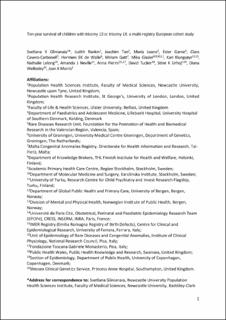Ten-year survival of children with trisomy 13 or trisomy 18: A multi-registry European cohort study
Glinianaia, Svetlana V.; Rankin, Judith; Tan, Joachim; Loane, Maria; Garne, Ester; Cavero-Carbonell, Clara; De Walle, Hermien E. K.; Gatt, Miriam; Gissler, Mika; Klungsøyr, Kari; Lelong, Natalie; Neville, Amanda; Pierini, Anna; Tucker, David F.; Urhoj, Stine Kjaer; Wellesley, Diana Gay; Morris, Joan K.
Journal article, Peer reviewed
Accepted version
Permanent lenke
https://hdl.handle.net/11250/3073344Utgivelsesdato
2023Metadata
Vis full innførselSamlinger
Originalversjon
Archives of Disease in Childhood. 2023, 108 (6), 461-467. 10.1136/archdischild-2022-325068Sammendrag
Objective: To investigate the survival to 10 years of age of children with trisomy 13 (T13) and children with trisomy 18 (T18), born 1995–2014.
Design: Population-based cohort study that linked mortality data to data on children born with T13 or T18, including translocations and mosaicisms, from 13 member registries of EUROCAT, a European network for the surveillance of congenital anomalies.
Setting: 13 regions in nine Western European countries.
Patients: 252 live births with T13 and 602 with T18.
Main outcome measures: Survival at 1 week, 4 weeks and 1, 5 and 10 years of age estimated by random-effects meta-analyses of registry-specific Kaplan-Meier survival estimates.
Results: Survival estimates of children with T13 were 34% (95% CI 26% to 46%), 17% (95% CI 11% to 29%) and 11% (95% CI 6% to 18%) at 4 weeks, 1 and 10 years, respectively. The corresponding survival estimates were 38% (95% CI 31% to 45%), 13% (95% CI 10% to 17%) and 8% (95% CI 5% to 13%) for children with T18. The 10-year survival conditional on surviving to 4 weeks was 32% (95% CI 23% to 41%) and 21% (95% CI 15% to 28%) for children with T13 and T18, respectively.
Conclusions: This multi-registry European study found that despite extremely high neonatal mortality in children with T13 and T18, 32% and 21%, respectively, of those who survived to 4 weeks were likely to survive to age 10 years. These reliable survival estimates are useful to inform counselling of parents after prenatal diagnosis.
